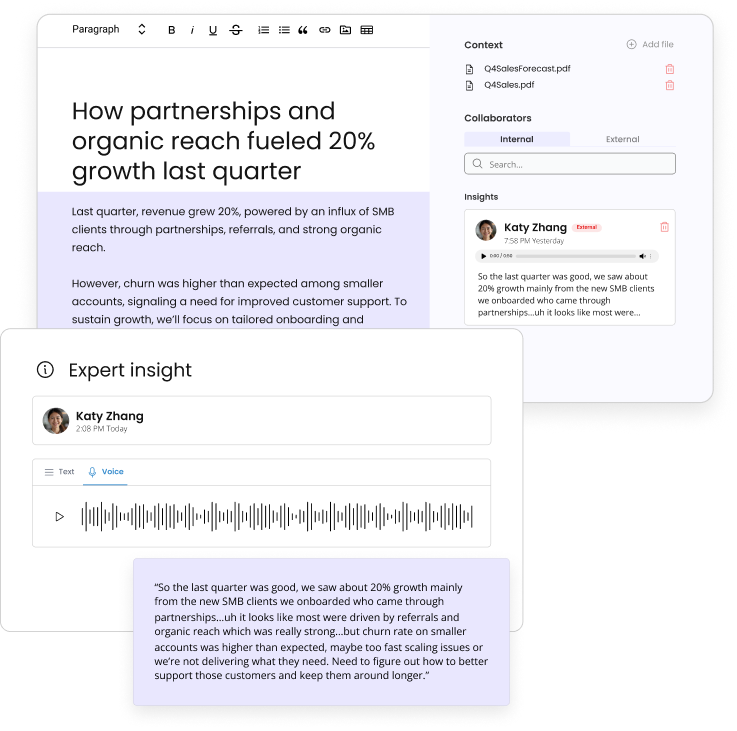Table of Contents

Authority scales when expertise comes first
Wordbrew helps teams collect expert insight before AI ever writes a word.
Built for expert-led, review-safe content
- Home
- »
- Content Marketing
- »
- Harnessing Executive Thought Leadership—The Next String In Your Strategic Bow
-
Stacy Garrels
- 6 minutes read time
Harnessing Executive Thought Leadership—The Next String In Your Strategic Bow
- Home
- »
- Content Marketing
- »
- Harnessing Executive Thought Leadership—The Next String In Your Strategic Bow
Harnessing Executive Thought Leadership—The Next String In Your Strategic Bow
Table of Contents

Many companies and organizations are beginning to get a grasp on thought leadership and the benefits it can yield for their brand.
But what many are yet to grasp is their secret weapon: executives.
Executive thought leadership has emerged as a key differentiator as leaders make themselves heard as experts in their field. This conveniently reflects well on their brand too, attracting a much wider audience.
By tapping into the wealth of knowledge, experience, and vision that executives possess, organizations can provide valuable insights and contribute to important conversations in their industry and beyond, setting themselves well apart from competitors and gaining trust among customers and stakeholders.
In this blog post, we’ll delve deeper into what executive thought leadership is all about, what makes an executive thought leader so powerful, and how you can take your thought leadership strategy to the next level. Let’s dive in.
TL;DR
- Executives are uniquely positioned to expand their thought leadership, thanks to their powerful combination of experience in leadership and in the wider industry.
- Executive thought leaders are not only trendsetters, but also often inspire wider society to move with their vision.
- Strong communication skills, resilience, expertise, and a willingness to adapt makes executives great thought leaders.
- To boost your thought leadership presence, try diversifying your content strategy by leveraging social media, going to industry events, and collaborating with other thought leaders.
- Measuring and adapting your thought leadership strategy is essential for sustained, long-term impact—keep an eye on your KPIs, audience feedback, and changes in your industry to stay relevant.

What is executive thought leadership?
As we’ve discussed before, thought leadership is all about sharing valuable insights and perspectives on industry trends and issues. And who could be better placed to do this than executives?
At the helm of their business or brand, many executives have the expertise and experience necessary to become a thought leader in their industry. In turn, they lend their own authority to that of the organization they represent.
Indeed, thought leadership is gaining momentum as a crucial concept in the business world. With the rise of social media and countless digital platforms, executives have more opportunities than ever before to share their unique knowledge with anyone who’s interested.

As such, thought leadership has become a powerful tool in building brand reputation, driving organic traffic, and fostering meaningful connections with customers and peers alike.
How executives shape industry trends
Executives are uniquely positioned to influence the direction of an industry. Why? Because, as leaders, they have the ability to drive change and make strategic decisions, and as experienced professionals, they have a deep understanding of the industry’s complexities, opportunities, and challenges. It also helps that they probably got to where they are today thanks to strong communication and networking skills, which enable them to effectively share their knowledge and build relationships with other key players in the industry.
Take Sheryl Sandberg, for example, who served as COO of Meta Platforms from 2008 to 2022. With her bestselling book, “Lean In,” and the subsequent organization she founded, Lean In Foundation, she shaped the tech industry by challenging traditional gender roles and advocating for women’s empowerment in the workplace.
As she shared her experiences and insights, countless women felt empowered to pursue leadership roles, which in turn sparked important conversations about workplace equality. As a result, Sandberg is a fantastic example of a powerful thought leader whose influence managed to even spill beyond her own field and into society as a whole.
What makes an effective thought leader?
Indra Nooyi, Satya Nadella, Ursula Burns, and Richard Branson—what do all of these successful thought leaders have in common? Well, effective thought leaders do usually share a number of common traits, which can be broken down as follows…

How to boost your presence as an executive thought leader
Once the foundation of thought leadership has been laid, it’s important to build it up and maximize its impact by engaging with key audiences and amplifying your reach. This might involve upping your current game, using social media platforms, attending industry events, or working together with your peers.
Let’s dive into all of those now.
- Diversify your current strategy
It might sound simple, but this requires some creativity. For example, take your current content and think, “How could I reach more people with this?” This might involve turning a blog post into a podcast episode or a white paper into a snazzy infographic. Doing so will strengthen your output and help you to reach a wider audience with varying content preferences.
- Leverage your social media platforms
All kinds of social media bring you closer to your audiences, but LinkedIn and Twitter offer particularly powerful ways to connect with other thought leaders and spread your message. But remember: social media is social—it’s two-way conversation. Respond to comments and engage with your followers to build a loyal and engaged audience that will be more likely to share your content and amplify your message.
- Attend industry events and conferences
Networking, participating in panels, and engaging with attendees are all great ways to build relationships within the industry and gain valuable exposure. And let’s not forget, the more recognizable you become, the more credibility is bestowed upon the brand you represent.
But it’s not just about showing up and giving a speech. To truly maximize the impact of your thought leadership presence, it’s important to be strategic about the events you attend and the message you deliver.
- Collaborate with influencers and other thought leaders
Teamwork makes the dream work, and working with others can do wonders for your reach and credibility within your industry. For example, by building relationships with others who share your values and interests, you might even be able to create a community of experts who support and amplify each other’s messages.
But there is more to this than just helping people to support you—one must approach collaboration with a mindset of mutual benefit and shared goals. By working together to create content and share insights, you can build long-lasting relationships that will give everyone a boost in the long run.

Measuring the impact of thought leadership
Finally, as always, it’s important to create a positive feedback loop of experimenting, tracking progress, and adjusting over time. After all, if there’s one thing a thought leader isn’t, it’s stagnant. Let’s explore how we can make sure that doesn’t happen to you.
- Track your key performance indicators (KPIs)
Keep an eye on metrics for website traffic, social media engagement, and lead generation—all of these provide valuable insight into how successful your thought leadership strategy is working. Allocate a time to revisit these metrics regularly so that you can identify areas of strength and weakness and make adjustments as needed.
- Take audience engagement and feedback onboard
Engaging with your audience and gathering feedback is an essential part of any thought leadership strategy, because a key part of your role will be to build relationships with those who actively engage with you. So, respond to comments, take note of their ideas, and refine your messaging over time.
- Adapt and evolve
Finally, it’s important to remember that a successful thought leader is one that keeps their finger on the pulse of change—so why would your strategy be any different? In fact, the most successful executives are usually the ones who can pivot to meet the needs of their audiences, so remain flexible and responsive for long-term success.
The bottom line
Embracing executive thought leadership can be a game-changer for organizations that want to stay ahead of the curve and make their mark in today’s competitive landscape. The key? Leveraging all the skills executives have picked up along their professional journey: expertise, vision, communication, resilience, and influence. I.e., don’t just follow the trends—create them! And in doing so, unlock your full potential and carve out a prominent space in your industry.
